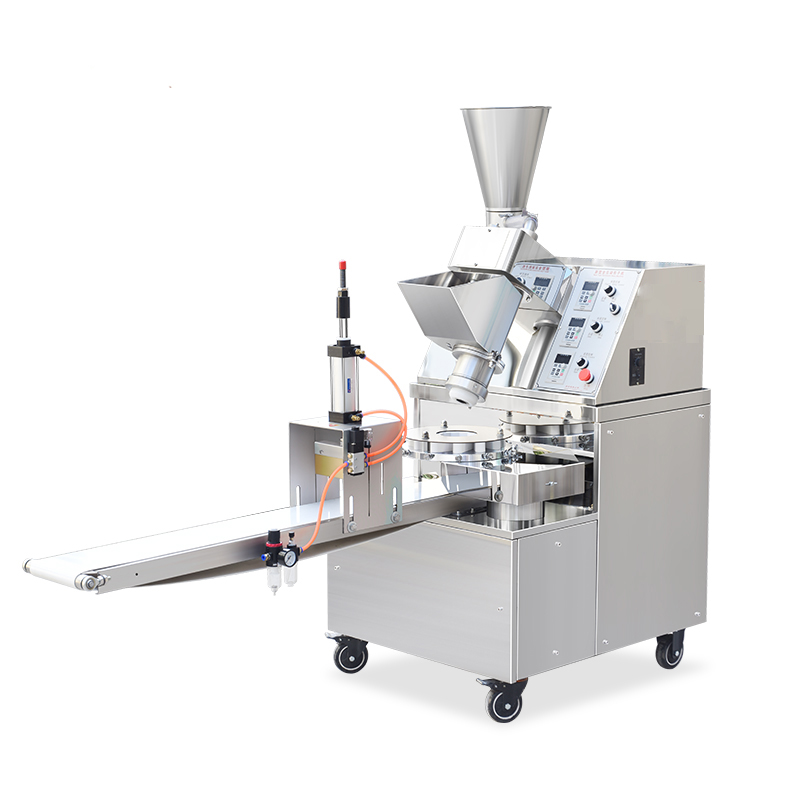A steamed bun machine is a machine that processes dough and fillings through mechanical equipment to produce steamed bun products of various specifications. The use of automation technology combines multiple steps in the traditional manual production process to achieve fast and standardized production. The steamed bun machine can mass-produce steamed buns with high consistency and stable quality in a short period of time, greatly improving production efficiency.

| Technical Parameters: | |
| Overall dimensions: | 1900*700*1600mm |
| Voltage: | 220V |
| Power: | 1.5kW |
| Production: | 0-3000 pieces/hour |
| Weight: | 190kg |
| Conveyor belt height from ground: | 550mm |
Applications
Traditional Chinese steamed buns: such as meat buns, vegetable buns, bean paste buns, etc.
Western fermented pastries: such as small bread and other fermented pasta that needs to be steamed.
Frozen instant buns: can be used to produce steamed buns in the quick-frozen food industry, which is convenient for later frozen storage and rapid heating.
Creative buns: customized buns are made according to different taste requirements, such as grain buns, custard buns, etc.
Features
High efficiency: Compared with manual production, steamed bun machines can mass-produce steamed buns in a short period of time, significantly improving production efficiency.
Consistency: Automated equipment can accurately control the size, weight and shape of each steamed bun, so that the quality of each steamed bun is consistent.
Multi-function: Modern steamed bun machines can usually adjust the production of steamed buns of different specifications and shapes according to demand to meet different market needs.
Save time and effort: Automated equipment reduces dependence on manual labor, reduces labor costs, and reduces errors in manual operation.
Hygiene and safety: The design of stainless steel material and sealed structure ensures the hygiene standards of the equipment and avoids cross contamination that may occur in manual production.
Application areas
Catering industry: Various small and medium-sized restaurants, pastry shops, etc. use steamed buns to make steamed buns, providing fast and standardized bun service.
Food processing plants: Large and medium-sized food processing plants are used to mass-produce steamed buns, quick-frozen buns, etc., suitable for large-scale production and supply chain distribution.
Chain restaurants: Chain catering brands use steamed buns to achieve unified standard product production to keep the product taste consistent in each store.
Hotels and breakfast supply: Hotels and large breakfast suppliers use steamed buns to make various breakfast buns to meet the needs of a large number of customers.
School and factory canteens: Large-scale catering places such as schools and factory canteens can use steamed buns to efficiently make a large number of steamed buns and provide fast food services for a large number of people.
Common problems with steamed bun machines
Poor taste of steamed buns
Problem cause: The taste of steamed buns may be affected by insufficient dough fermentation time, improper filling ratio or insufficient steaming time.
Solution: Check whether the dough is fully fermented, adjust the moisture and fat ratio of the filling, and ensure that the steaming time of the steamed bun meets the requirements.
Rough surface of steamed buns
Problem cause: The surface of steamed buns may become rough due to insufficient dough kneading or improper equipment settings.
Solution: Increase the dough kneading time, ensure the uniformity of the dough, and check whether the equipment parameters are set correctly.
Filling leakage
Problem cause: Uneven filling or poor sealing of the bag mouth will cause filling leakage during steaming.
Solution: Adjust the filling amount, ensure that the bag mouth is tightly sealed, and increase the dough thickness appropriately.
Abnormal operation of equipment
Problem cause: It may be caused by wear of internal parts of the equipment, power failure or improper operation.
Solution: Check the internal parts of the equipment regularly, ensure that the equipment is well maintained, and refer to the equipment manual for correct operation.
Inconsistent steamed bun size
Problem cause: The inconsistent size of steamed buns may be caused by uneven dough cutting or incorrect machine parameter settings.
Solution: Adjust the dough cutting device of the machine to ensure that the cut dough pieces are of the same size, and check whether the equipment settings are correct.
Equipment cleaning is difficult
Problem cause: The steamed bun machine may accumulate flour and fillings after long-term use, which is difficult to clean.
Solution: Choose equipment that is easy to disassemble and made of stainless steel for easy cleaning and maintenance. Clean the equipment regularly to avoid accumulating too much residue.
Steamed bun machine is one of the indispensable equipment in the modern food processing industry. Through automation technology, the traditional manual steamed bun process has been simplified, significantly improving production efficiency and product consistency. The widespread use of steamed bun machines has enabled Chinese buns to be promoted and produced more efficiently, especially in the catering industry, food processing plants and chain restaurants. With the continuous advancement of technology, the function and adaptability of steamed bun machines are also constantly improving, and they will be used in more food processing scenarios in the future.